Discover the Enchantment of Yellowstone Lakes: A Visitor’s Guide
As iconic landmarks treasured by millions, Yellowstone National Park’s breathtaking lakes encapsulate the park’s natural splendor. However, many visitors overlook their hidden gems while beelining to Old Faithful.
This guide unlocks insider secrets to experience Yellowstone’s lakes beyond the crowds—from scenic trails and rejuvenating dips amid steaming geothermal features to world-class trout fishing or canoeing into the backcountry far from roads.
Yellowstone lakes offer outdoor adventure, wildlife watching, and spiritual reconnection for all ages, revealing a lifetime of moments for those who discover their subtle magic. This complete guide serves as your cheat sheet to create your enchantment.
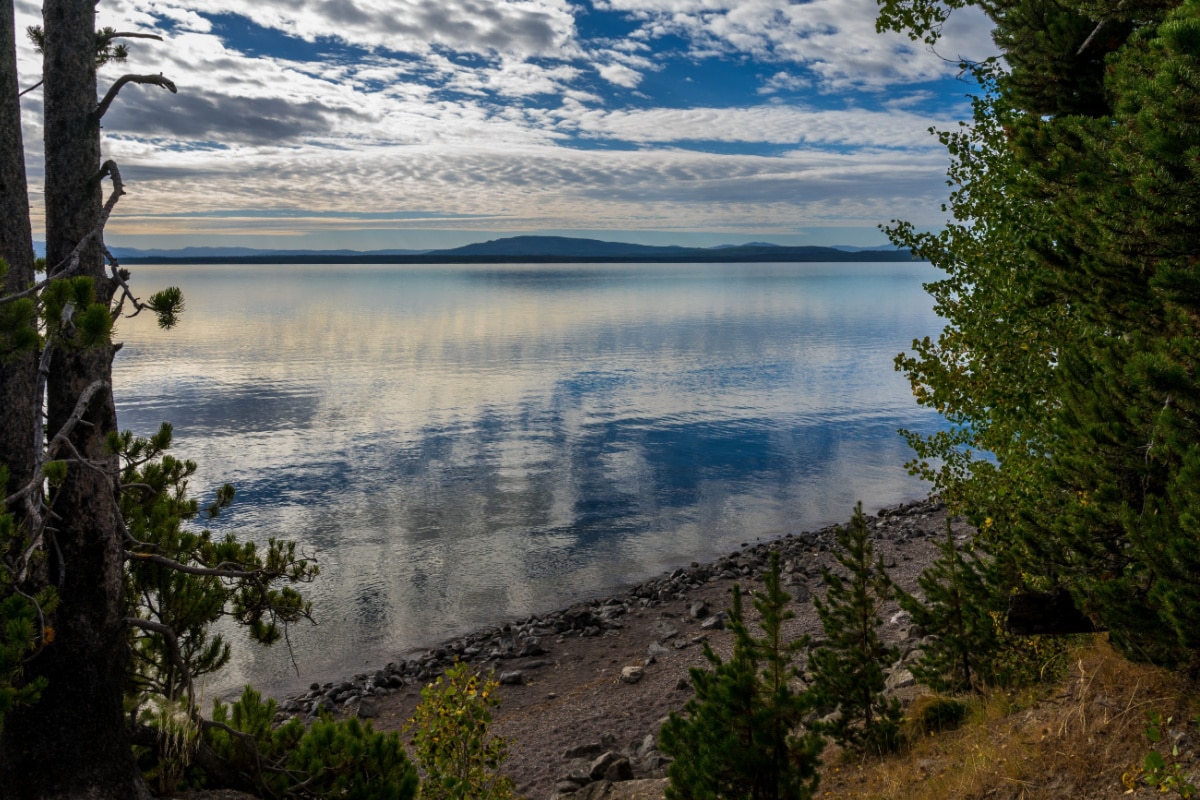
Yellowstone Lake: A Spectacular Centerpiece
As the largest high-altitude lake in North America, Yellowstone Lake is an iconic landmark and centerpiece of Yellowstone National Park. Spanning over 132 square miles with 110 miles of shoreline, its vast expanse and natural beauty make it a sight.
Yellowstone Lake also serves as a window into the park’s unique geological features. Its location atop the Yellowstone Caldera provides visitors with a firsthand look at hydrothermal explosions that have shaped the lake’s basins and Yellowstone’s famous geysers.
Scenic Overlooks
When exploring Yellowstone Lake, one of the best places to take in the views is from Lake Village on the north shore. Situated near the water’s edge, sweeping vistas of the Absaroka mountain range reflect off the lake’s clear waters. Along the southeast arm, the West Thumb area similarly rewards visitors with panoramic lookouts over the lake’s jagged coastline.
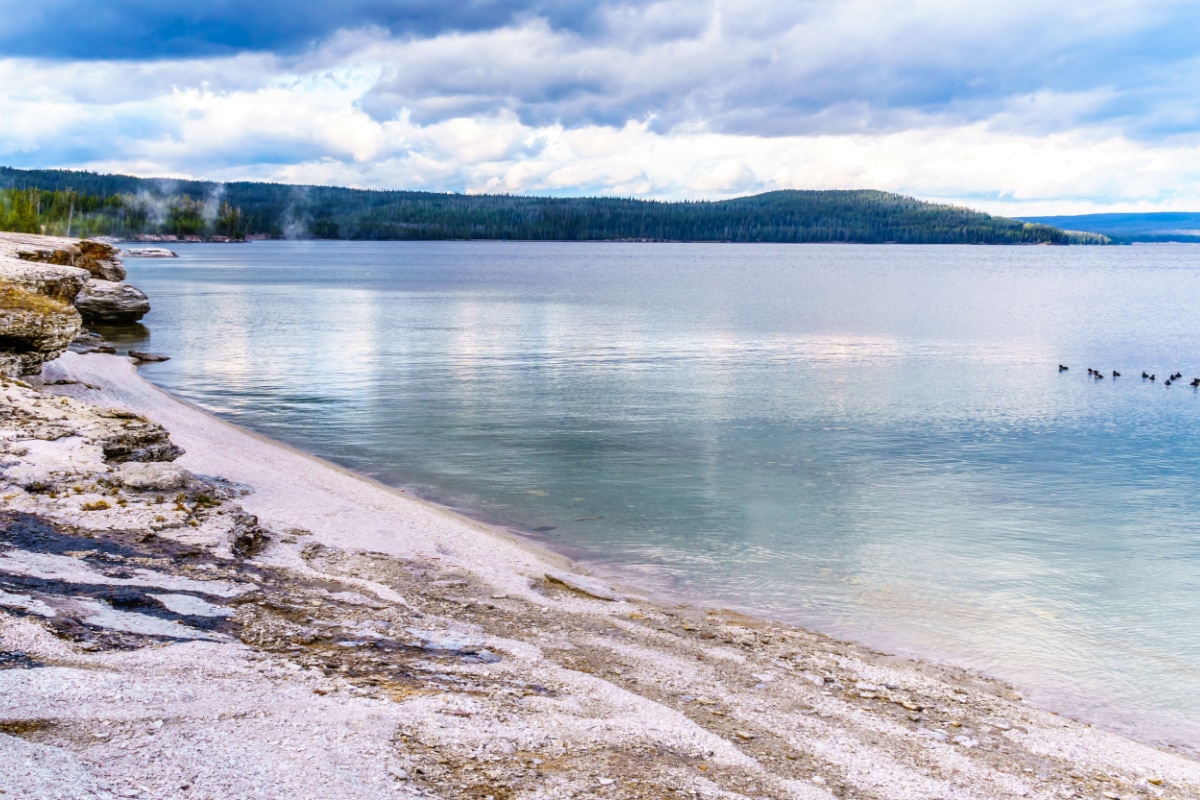
Recreational Activities
In addition to sightseeing, Yellowstone Lake offers a variety of recreational activities. Anglers can cast their lines for native cutthroat trout, while paddlers and boaters can explore the lake’s secluded coves and inlets. With hundreds of backcountry campsites dotted around the shoreline, the lake also serves as a gateway for multi-day adventures into Yellowstone’s remote wilderness.
During winter, portions of the frozen lake become paved highways for snowmobiles and coaches. Visitors can glide across the ice to unique destinations like the West Thumb Geyser Basin before its boardwalks become crowded in summer.
No matter the season, Yellowstone Lake captures the imagination with its wild beauty and opportunities for adventure. For a one-of-a-kind experience, travelers shouldn’t miss discovering Montana’s inland sea.
Recreational Activities at Yellowstone Lake
As the focal point of Yellowstone National Park, it’s no surprise Yellowstone Lake offers many family-friendly outdoor adventures. From boating and fishing to hiking and wildlife viewing, the lake provides a playground for visitors seeking memorable experiences amid spectacular scenery.
Boating and Paddling
Bridge Bay Marina provides motorboat and paddle boat rentals for boating enthusiasts to explore the lake’s sprawling waters. Visitors can chart their course to secluded coves or opt for ranger-guided tours revealing fascinating history and geology. Kayakers and canoers can similarly embark on half-day or full-day trips, while stand-up paddleboards deliver more serene lakefront exploration.
Angling and Fly Fishing
Brimming with cutthroat trout, Yellowstone Lake offers bountiful fishing from boats or shore. The Lake Hotel opens early to provide rowboat and pole rentals for diehard anglers trying their luck at the famous Thorofare fishing hole. Guided fly fishing tours can relieve beginners’ stress while revealing prime spots only accessible by boat.
Scenic Lookouts and Trails
Those interested in taking in Yellowstone Lake’s beauty have myriad hiking trails and scenic lookouts to enjoy breathtaking panoramas. Popular outings include the Elephant Back Loop Trail with its sweeping lake vistas or the Natural Bridge Trail culminating in the 50-foot Natural Bridge spanning a colorful gorge. With over 100 miles of lakefront, you’re guaranteed to discover picture-perfect scenes around every bend.
Shoshone Lake: A Secluded Gem
Shoshone Lake is one of the Yellowstone lakes tucked away in the backcountry. It offers a gateway to solitude amid pristine wilderness. At 8,050 feet of over 8,000 acres, it beckons adventurers willing to leave crowds behind in search of an unspoiled mountain retreat.
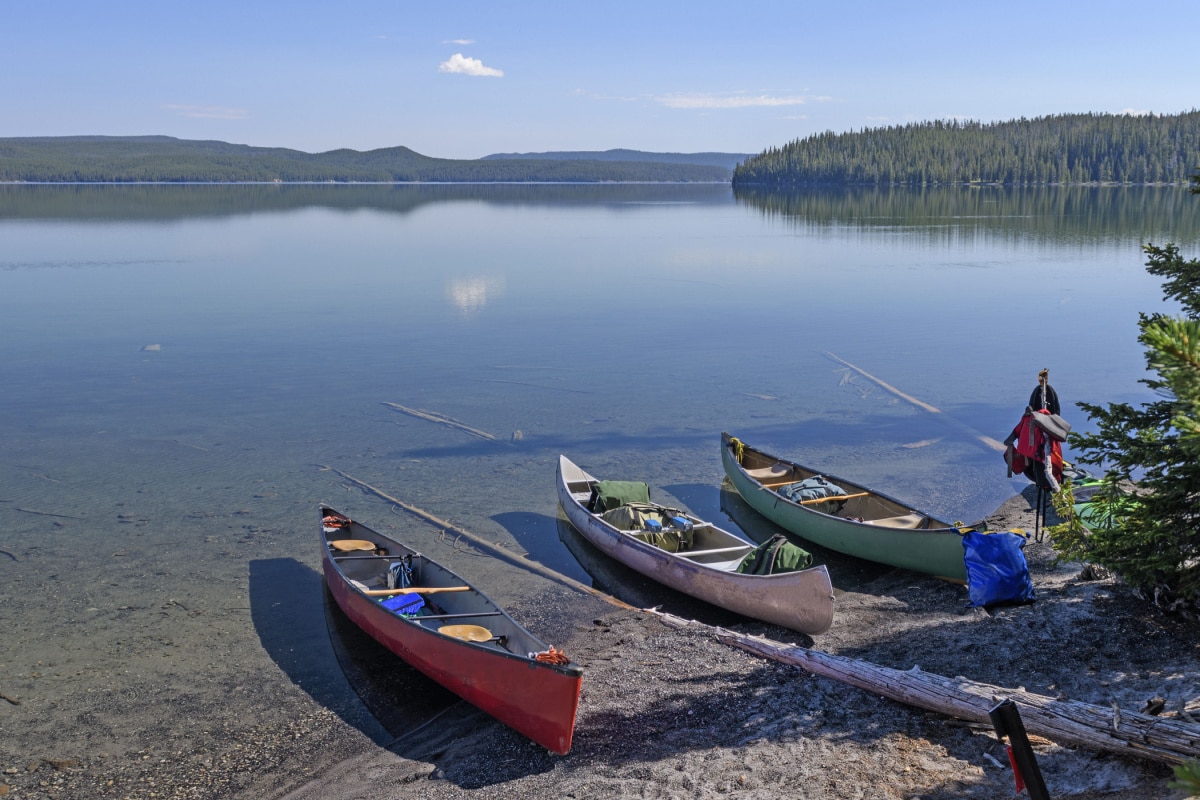
Accessible only by trail, Shoshone Lake rewards intrepid hikers with the chance to camp lakeside in perfect seclusion. Designated campsites dot the shoreline, providing prime access for fishing, paddling, and soaking in the peace of nature undisturbed.
For those keen to explore further, the Shoshone Geyser Basin sits a short hike away. Its mineral terraces and boiling springs demonstrate Yellowstone’s living geology, contrasting beautifully against the lake’s azure waters. In autumn, the rustic backcountry erupts in a spectacle of color thanks to lush forests of lodgepole pine and quaking aspen encircling the lake. The fall foliage provides a painter’s palette of yellows, oranges, and reds reflecting over the glassy water.
Heart Lake: A Heart-Shaped Wonder
At the base of Mount Sheridan, Heart Lake encapsulates Yellowstone’s romantic side with its naturally heart-shaped shoreline. The three-mile hike along the rugged Mount Sheridan Trail rewards visitors with one of the most iconic (and Instagrammable) scenes in all of the Yellowstone lakes.
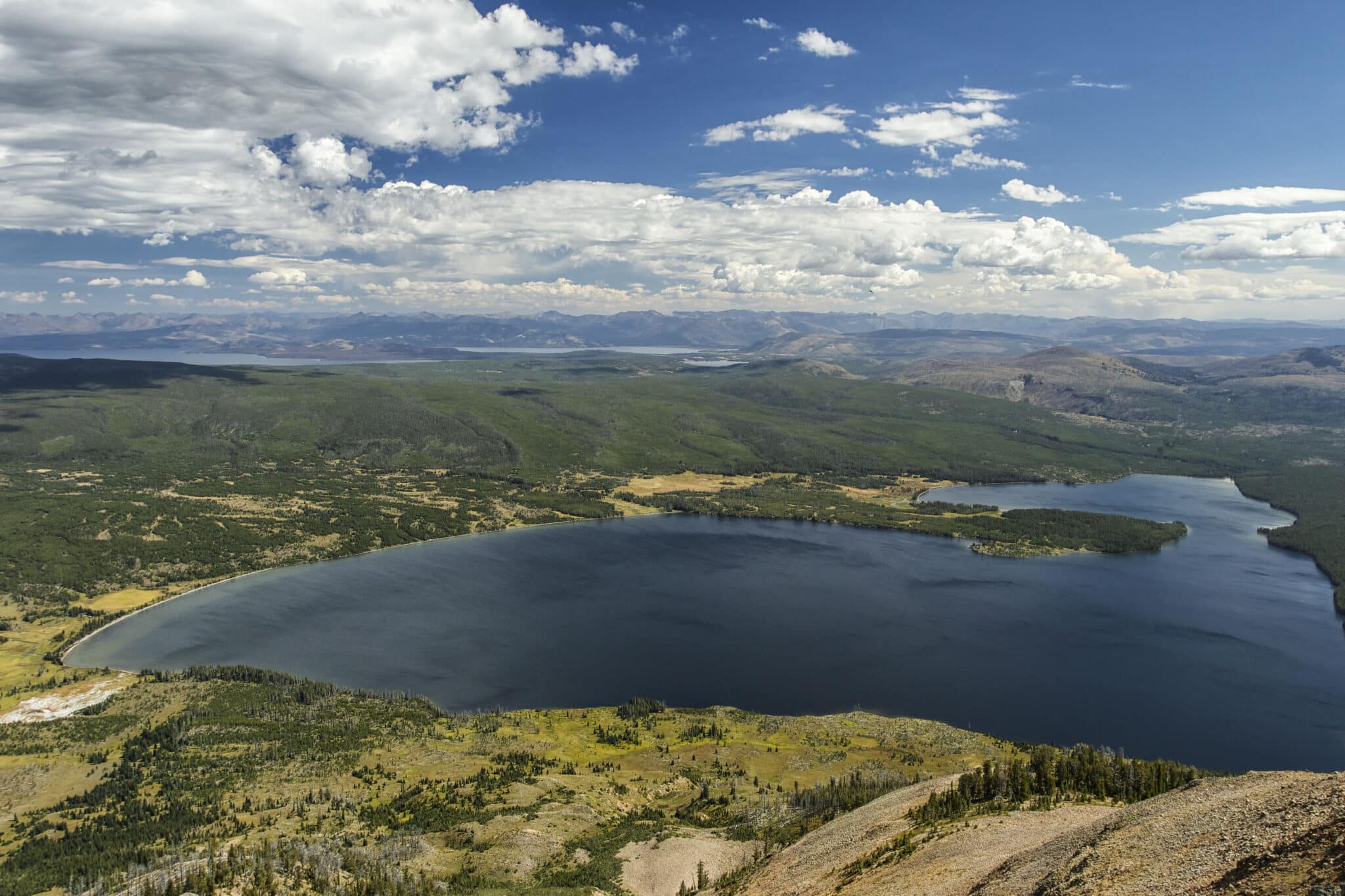
Surrounded by dramatic peaks and forests, Heart Lake offers much more than photo ops, thanks to the diverse wildlife inhabiting its shores and nearby meadows. Bighorn sheep regularly descend to its willow-lined banks while grizzly bears emerge to fish for native cutthroat trout teeming in the lake. Heart Lake also provides refuge for elusive animals like wolverines, mountain lions, and gray wolves that roam the sublime wilderness.
Anglers can cast lines from the lakeshore, or backcountry campers can paddle among lily pads dotting the glassy turquoise water. An extension trail continues two miles beyond for a pinch of adventure, traversing active geothermal features bubbling within the Heart Lake Geyser Basin.
In any season, Heart Lake presents hallmarks of Yellowstone’s trail less-taken. Between peak fall colors mirroring its waters or moonlit summer nights under the stars, the journey promises lasting memories within a landscape beautifully carved by nature. Whether during summer or fall, Shoshone Lake offers an escape to simplicity. Returning to Yellowstone’s early frontier days, visitors can revel in the park’s overlooked gems, far from the modern world of cars and crowds.
Lewis Lake: Gateway to the South
Sitting south of Yellowstone Lake, Lewis Lake provides a peaceful gateway to Yellowstone’s lower geyser basins and Grand Teton’s northern reaches. Spanning over 1,500 acres, Lewis Lake offers a tranquil retreat amid lodgepole forests and wildflower meadows ripening under commanding views of Mount Sheridan.
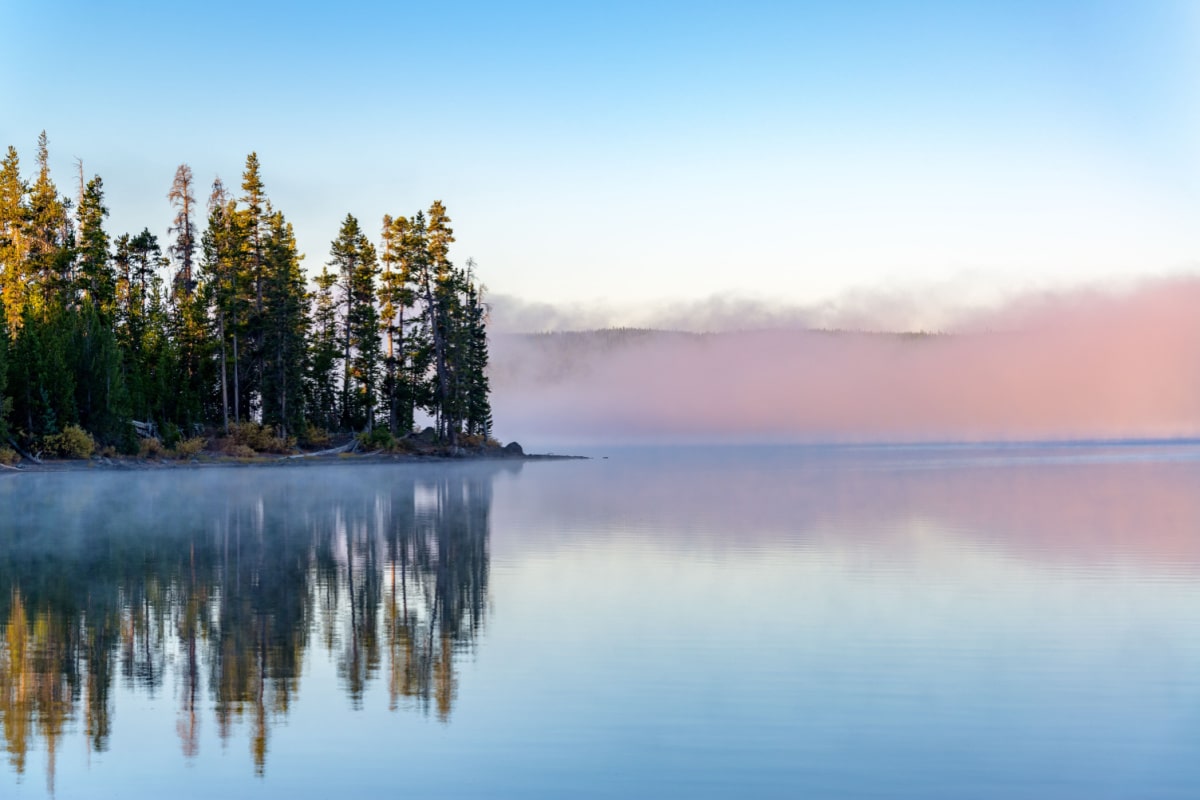
Anglers flock to Lewis Lake thanks to its bounty of Yellowstone cutthroat trout, brown trout, and brook trout lurking in the shallow turquoise waters. From buckets of bite-sized brookies to lunker-sized cuts, the fishing seldom disappoints. Those less interested in casting lines can revel in scenic views along the meandering Lewis River Channel or picnic at the serene Lewis Lake campground.
Hikers also have mile access to Shoshone Lake Trailhead with its backcountry access to cols high above the tree line. And thanks to the lake’s location next to the highway, visitors can easily pair Lewis Lake adventures with exploring Yellowstone icons like Old Faithful only 30 minutes north. Whether for a few hours or full days, Lewis Lake supplies the perfect jumping-off point for southern Yellowstone explorations.
Wildlife and Natural Beauty Around Yellowstone Lakes
Beyond their beauty, Yellowstone’s lakes provide vital habitat for diverse wildlife while granting visitors front-row seats to nature’s show. Early risers can catch moose feeding at marshy lake shores at dawn or spot ospreys diving to snag unsuspecting trout. Patients might glimpse river otters slipping into the water at dusk or hear elk bugling across mist-veiled lakes.
The lakes also host migratory birds that pass through in spring and fall, from trumpeter swans floating gracefully across open waters to sandhill cranes squawking from crowded shorelines. Quiet paddlers may even surprise bobcats stalking the banks or beavers busily swimming by with fresh branches clamped in their teeth.
For avid birdwatchers, the northwestern arm of Yellowstone Lake by the Yellowstone River inlet offers exceptional sightings. Here birds converge to feed on rising insects, nest in riverside cottonwoods, or rest on their long migrations. Prime spots include the River Trail and picnic area near Fishing Bridge, where spotting scopes can reveal everything from American white pelicans to Barrow’s goldeneye ducks. Early mornings present the best chance to observe rare birds like harlequin ducks quietly paddling the river’s rushing waters from the shore or a river boat.
And thanks to the spectacular terrain surrounding most lakes, visitors can pair wildlife watching with admiring breathtaking scenery. Photographers will delight in mirror-like reflections of towering pines and dramatic mountain peaks adorning calm waters. Sunrises and sunsets set the lakes aglow in stunning hues ranging from fiery orange and fuchsia to serene lavenders and blues.
For those captivated by fall foliage, forests surrounding Shoshone and Lewis Lakes deliver a dazzling display of golden aspens and scarlet sumac contrasting beautifully with intense blue water. And in spring, wildflowers like glacier lilies, Indian paintbrushes, and elephant head lilies in spring complement Heart Lake’s sapphire shallows. For nature lovers, Yellowstone’s scenic lakes offer endless inspiration through their diverse beauty and inhabitants, no matter the season.
Best Times To Visit and Practical Tips
Although magnificent year-round, Yellowstone’s lakes shine brightest during summer. Trails and campgrounds open in late May before crowds arrive. June’s long days offer 19 hours of daylight exploring wooded lake shores blooming with wildflowers. July and August bring warm waters for swimming and steamy weather, making early mornings ideal for wildlife viewing and midday adventures like paddling. As autumn approaches, thin crowds, bug-free hiking, and stunning foliage make September and October perfect for backcountry treks.
When visiting, stop at park information centers for maps, permits, and updates on recent animal sightings or trail closures. Prepare essentials like hiking boots, layers, rain gear, and bear spray for venturing into Yellowstone’s wilderness. And don’t forget the camera – scenic turnouts around nearly any lake promise exceptional photo opportunities.
Overnight visitors can bunk in historic Lake Village cabins on Yellowstone Lake’s north shore or camp lakeside at Bridge Bay. Lewis Lake, Grant Village, and Lake campgrounds provide camping adjacent to scenic waters. Heart Lake offers remote backcountry sites reachable only by hardy hikers, while Shoshone Lake requires backcountry permits for multiday canoe trips or rugged hiking camps.
Remember Yellowstone’s motto to travel cautiously with respect for wildlife no matter the season. Always keep safe distances from grazing elk, nesting ospreys, or curious moose you encounter. And when paddling crystal waters, don’t approach hot springs, muddy banks, or diving birds. Treating Yellowstone’s splendor with care, its enchanting lakes will endure for generations, a promising adventure for those willing to wander its spectacular frontiers.
Conservation and Sustainability
As iconic landmarks treasured by millions, preserving Yellowstone’s lakes remains crucial for safeguarding the park’s ecological health. However, balancing visitor access with conservation poses an ongoing challenge requiring proactive solutions.
On Yellowstone Lake, intensive research by the National Park Service tracks concerning drops in native cutthroat trout populations due to predation by invasive lake trout. Gillnetting operations annually remove over 200,000 nonnative fish to curb this imbalance, helping revive cutthroat numbers. Visitors can assist conservation efforts by following regulations on keeping or releasing certain catches.
Travelers also play a crucial role by practicing sustainable habits, from properly disposing of trash to avoiding wildlife disturbances. Avoid bathing with soap and stick to designated trails and lookouts when camping roadside at famous lakes. For remote waters like Shoshone Lake, strictly pack out all waste to leave the pristine backcountry unimpaired.
By informing themselves and making conscientious choices, visitors can prevent recreational love for Yellowstone’s lakes from becoming ecological peril. If tourists embrace roles as temporary stewards, these resplendent waters will endure unspoiled for generations—as they should for another million years.
Yellowstone at a Glance
Ultimately, Yellowstone’s spellbinding lakes offer a lifetime of exploration for those seeking outdoor adventure, spiritual rejuvenation, or peace amid nature’s splendor. As the crown jewels anchoring this treasured park, a visit here remains incomplete without time to discover their subtle magic.
Whether boating across Yellowstone Lake’s vast expanse, fly fishing for native trout at Lewis Lake, or soaking in a hidden backcountry hot spring near Heart Lake, intimate experiences await off the beaten path. And by practicing sustainable travel, we can ensure these resplendent waters endure for generations. For an unforgettable journey, wander beyond Old Faithful to unlock Yellowstone’s lakes’ enchantment on your next park visit.
This article originally appeared on Wealth of Geeks.

